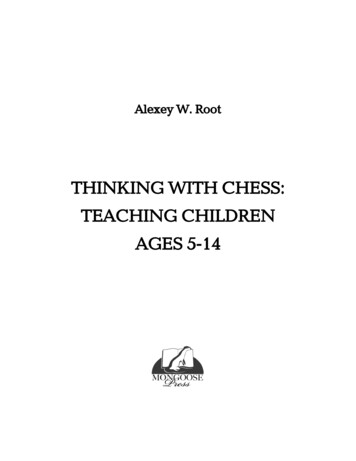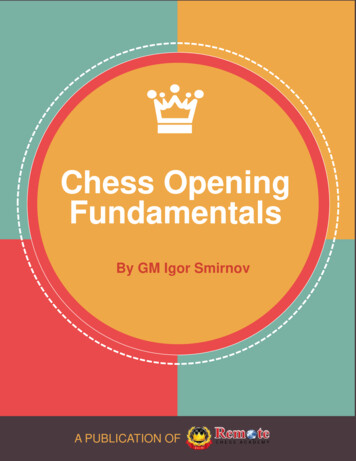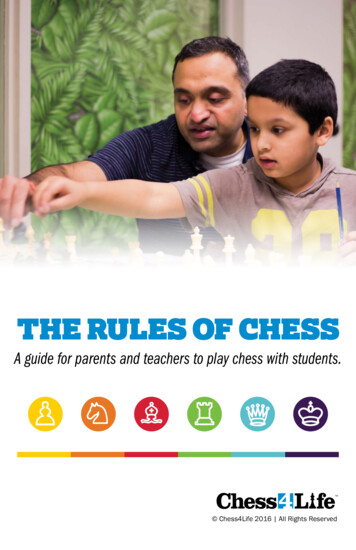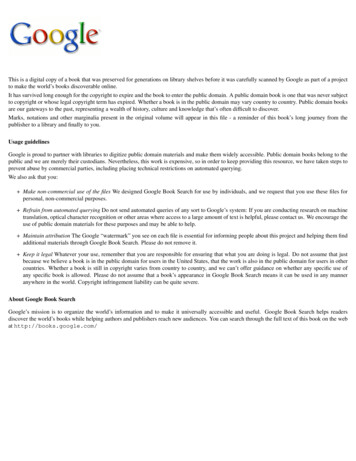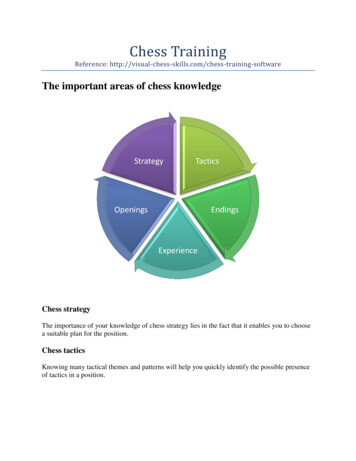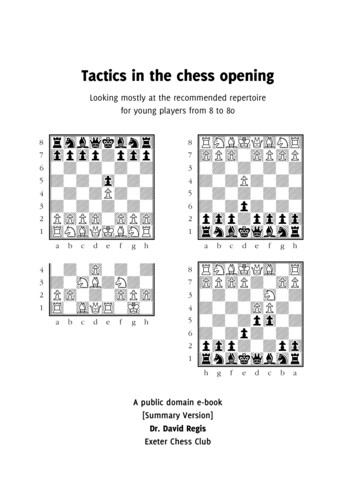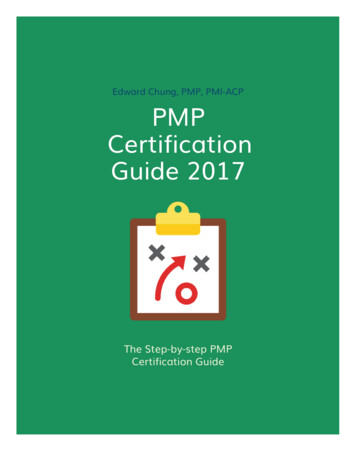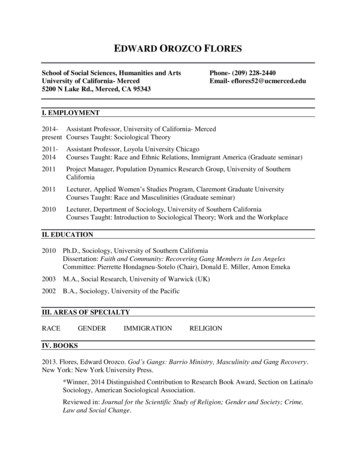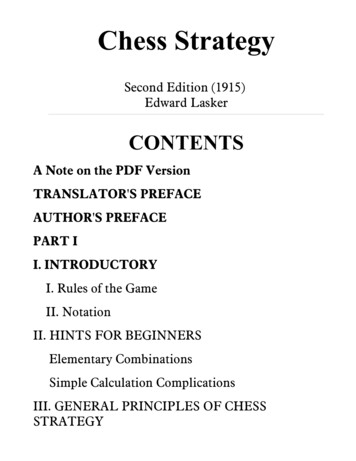
Transcription
Chess StrategySecond Edition (1915)Edward LaskerCONTENTSA Note on the PDF VersionTRANSLATOR'S PREFACEAUTHOR'S PREFACEPART II. INTRODUCTORYI. Rules of the GameII. NotationII. HINTS FOR BEGINNERSElementary CombinationsSimple Calculation ComplicationsIII. GENERAL PRINCIPLES OF CHESSSTRATEGY
IntroductoryBalance of Attack and DefenceMobilityIV. THE OPENINGDevelopment of the PiecesOn Losing MovesExamples of Practical PlayPawn PlayPawn SkeletonThe CentreA. King's Pawn GamesB. Queen's Pawn GamesC. Irregular OpeningsV. THE END-GAMEEnd-games with PiecesPawn Endings MixedEndingsEND-GAMES FROM MASTER-PLAY
Teichmann-Blackburne (Berlin, 1897)Ed. Lasker-Rotlewi (Hamburg, 1910)Blackburne-Schlechter (Vienna, 1898)Bird-Janowski (Hastings, 1895)Steiner-Forgacz (Szekesfehervar, 1907)Charousek-Heinrichsen (Cologne, 1898)VI. THE MIDDLE GAMEGeneral RemarksEvolution of the Pawn SkeletonObjects of Attack"Backward" PawnsOn Fixing a WeaknessWeaknesses in a Pawn PositionBreaking up the King's SideDoubled PawnsIllustrations—v. Scheve-Teichmann (Berlin, 1907)Marshall-Burn (Ostend, 1907)
Manoeuvres of the Pieces Open Files and DiagonalsExample—Fred. Lazard-Ed. Lasker (Paris, 1914)PART IIILLUSTRATIVE GAMES FROM MASTERTOURNAMENTS1.Tartakower-Burn (Carlsbad, 1911)2.Leonhardt-Marshall (San Sebastian, 1911)3.Spielmann-Prokes (Prag, 1908)4.Tarrasch-Capablanca (San Sebastian, 1911)4a. Howell-Michell (Cable Match, 1907)4b. X. v. Y5.Griffith-Gunston (London, 1902)6.Mason-Gunsberg (New York, 1889)7.Marshall-Tarrasch (Hamburg, 1910)8.Blackburne-Em. Lasker (Petrograd, 1914)9.Salwe-Marshall (Vienna, 1908)10.Teichmann-Amateurs (Glasgow, 1902)11.Schlechter-Janowski (Paris, 1900)12.Teichmann-Rubinstein (Carlsbad, 1911)13.Teichmann-Schlechter (Carlsbad, 1911)14.Spielmann-Tarrasch (San Sebastian, 1912)15.Aljechin-Niemzowitsch (Petrograd, 1914)16.Yates-Gunsberg (Chester, 1914)17.Berlin-Riga (1908-1909)
17a. Maroczy-Berger (Vienna, 1908)18.Em. Lasker-Capablanca (Petrograd, 1914)19.Ed. Lasker-Janowski (Scheveningen, 1913)20.Ed. Lasker-Englund (Scheveningen, 1913)21.Lasker-Aljechin (Scheveningen, 1913)22.Forgacz-Tartakower (Petrograd, 1909)23.Yates-Esser (Anglo-Dutch Match, 1914)24.Atkins-Barry (Cable Match, 1910)25.Lasker-Tarrasch (Munich, 1908)26.Capablanca-Blanco (Havanna, 1913)27.Niemzowitsch-Tarrasch (San Sebastian, 1912)28.Alapin-Rubinstein (Wilna, 1912)29.Teichmann-Spielmann (Leipzig, 1914)30.Tarrasch-Spielmann (Mannheim, 1914)31.John-Janowski (Mannheim, 1914)32.Laskcr-Mieses (Scheveningen, 1913)33.Barasz-Mieses (Breslau, 1012)34.Lasker-Niemzowitsch (Petrograd, 1914)35.Reti-Tartakower (Vienna, 1910)36.ForgaczCohn (Petrograd, 1909)37.Marshall-Capablanca (New York, 1909)38.Rotlewi-Teichmann (Carlsbad, 1911)38a. Rubinstein-Teichmann (Vienna, 1908)39.Rotlewi-Rubinstein (Lodz, 1907)40.Rubinstein-Capablanca (San Sebastian, 1911)41.Niemzowitsch-Tarrasch (Petrograd, 1914)41a. Lasker-Bauer (Amsterdam, 1889)
42.Capablanca-Aljechin (Petrograd, 1913)43.Capablanca-Bernstein (Petrograd, 1914)44.Dus Chotimirski-Vidmar (Carlsbad, 1911)45.Rubinstein-Spielmann (Pistyan, 1912)46.Thomas-Lasker (London, 1912)47.Tartakower-Asztalos (Budapest, 1913)47a. Tartakower-Spielmann (Vienna, 1913)47b. X v. Y48.Blackburne-Niemzowitsch (Petrograd, 1914)TABLE OF OPENINGSA.King's Pawn GamesB.Queen's Pawn GamesC.Irregular OpeningsA Note on the PDF VersionThis PDF version has been designed for reading on a 6inch ereader, specifically a Kobo. I found this as anHTML file. Unlike the original Gutenberg version, itincludes diagrams added by José Garcia. I edited theHTML and added CSS to change the fonts, make thembigger, and to make the diagrams bigger, as well as tocorrect some formating errors. The main body is in 22ptAldine721 BT, a clone of Plantin, and moves are in 20ptRockwell. I used OpenOffice Writer to export thefinished product to a PDF file. If you want to view it on
your computer, it will be best to view it one whole pageat a time. Otherwise, the fonts will appear too large.Although I have edited the formatting, I have not editedthe content. -- Fergus DunihoTRANSLATOR'S PREFACEAs the first edition of Edward Laskcr's CHESSSTRATEGY was exhausted within a comparativelyshort time of its appearance, the author set himself thetask of altering and improving the work to such anextent that it became to all intents and purposes a newbook. I had the privilege of co-operating with him to aslight degree on that second edition, and was inconsequence able to appreciate the tremendous amountof work he voluntarily took upon himself to do; I sayvoluntarily, because his publishers, anxious to supplythe strong demand for the book, wished to reprint it asit stood.A little later I undertook to translate this second editioninto English for Messrs. Bell & Sons. Only a fewmonths had elapsed, the tournaments at Petrograd,Chester, and Mannheim had taken place, several newdiscoveries had been made, and it is the greatesttestimony to Edward Lasker's indefatigable devotion tothe Art of Chess that I am able to say that this is not atranslation of the second edition, but of what ispractically a new book. It contains a new preface, a
chapter for beginners, a new introduction, newvariations. Furthermore, a large number of new gameshave taken the place of old ones.I have no doubt that any chess player who will take thetrouble to study CHESS STRATEGY will spend manya pleasurable hour. Incidentally new vistas will beopened to him, and his playing strength increased to asurprising degree.The author says in his preface that he appeals to theintelligence and not the memory of his readers. In myopinion, too, the student should above all try toimprove his judgment of position.Than the playing over of games contested by experts Ican hardly imagine a greater or purer form ofenjoyment. Yet I must at the outset sound a note ofwarning against its being done superficially, and with afeverish expectation of something happening. Everymove or combination of moves should be carefullyweighed, and the student should draw his ownconclusions and compare them with what actuallyhappens in the game under examination.This applies particularly to some of the criticalpositions set out in diagrams in the course of theexposition of the several games.The reader would derive the greatest possible benefit
from a prolonged study of such positions before seekingto know how the games proceed. After having formedhis own opinion about the merits of a particularposition, he should compare the result with the sequelin the game in question, and thus find out where hisjudgment has been at fault.The deeper study of the theory of the openings is ofcourse a necessity to the student who wishes to becomean expert, but the development of his judgment mustprecede it. To him Griffith & White's admirable book,Modem Chess Openings, will be a perfect mine ofinformation. There are thousands of variations, and inmost of them the actual game in which they were firsttried by masters is named, thus adding to the interestand value of the work.I must not omit to mention the invaluable help affordedme by my friend Mr. John Hart, to whom my warmestthanks are due.JULIUS DU MONT.AUTHOR'S PREFACETHE large majority of chess players who would like toimprove their game, have not the necessary opportunityof pitting themselves against players of master-strength,or at least of obtaining the desired instruction frompersonal intercourse with them. It is for such players
that the present work is intended. The books on whichthe learner has to rely hardly ever serve his purpose,being mostly little more than a disjointed tabulation ofnumberless opening variations, which cannot beunderstood without preliminary studies, andconsequently only make for confusion. In the end theconnection between the various lines of play maybecome clear, after the student has made an exhaustivestudy of the subject, but very few would have either thetime or the inclination for such prolonged labour.Therefore another shorter and less empirical way mustbe found in which to acquire the understanding ofsound play. My system of teaching differs from theusual ones, in that it sets down at the outset definiteelementary principles of chess strategy by which anymove can be gauged at its true value, thus enabling thelearner to form his own judgment as to the manoeuvresunder consideration. In my opinion it is absolutelyESSENTIAL to follow such strategical principles, and Igo so far as to assert that such principles are inthemselves SUFFICIENT for the development andconduct of a correct game of chess.Even though instruction in chess is possible on verygeneral lines alone, yet I think it advisable and indeednecessary to explain the application of such principlesto the various phases of each game of chess. Otherwise
the learner might unduly delay his progress, and losevaluable time in finding out for himself certainessentials that could more profitably be pointed out tohim.With regard to the way in which I have arranged mysubject and the form of its exposition in detail, I havethought out the following plan.After discussing at length the leading principlesunderlying sound play, I have first treated of theOPENINGS, in which such principles are of even moredeciding influence than in any other stage of the game,as far as could be done on broad lines without having topay attention to middle and end-game considerations.I proceeded as follows, by taking as my starting-pointthe "pawn skeleton" which is formed in the opening,and round which the pieces should group themselves inlogical fashion. As a consequence of the pawns havingso little mobility, this "pawn skeleton" often preservesits shape right into the end-game. Applying the generalstrategical principles to the formation of the pawnskeleton, the learner acquires the understanding of theleading idea underlying each opening without having toburden his memory. Not only that, he will also be ableto find a correct plan of development when confrontedwith unusual forms of opening.
The most important result of this system of teaching isthat the learner does not lose his way in a maze of detail,but has in view at the very outset, the goal which themany possible variations of the openings are intendedto reach.Before I could proceed to the discussion of the middlegame, I found it necessary to treat of the principlesgoverning the END- GAME. For in most cases play inthe middle game is influenced by end-gameconsiderations. Here also it has been my endeavour asfar as possible to reduce my subject to such principles asare generally applicable.Finally, as regards the MIDDLE GAME, to which thewhole of Part II is devoted, I have again made thehandling of pawns, the hardest of all problems ofstrategy, the starting-point for my deliberations. I haveshown at length how the various plans initiated by thevarious openings should be developed further. Toensure a thorough understanding of the middle game, Ihave given a large number of games taken from masterplay, with numerous and extensive notes. Thus thestudent has not to rely only on examples takenhaphazard from their context, but he will at the sametime see how middle-game positions, which giveopportunities for special forms of attack, are evolvedfrom the opening.
It has been my desire to make the subject easilyunderstandable and at the same time entertaining, andto appeal less to the memory of my readers than to theircommon sense and intelligence. I hope in that way notto have strayed too far from the ideal I had in mindwhen writing this book, namely, to apply to chess theonly method of teaching which has proved productivein all branches of science and art, that is, the educationof individual thought.If I have succeeded in this, I shall have the satisfactionof having contributed a little to the furthering, in thewide circles in which it is played, of the game whichundoubtedly makes the strongest appeal to the intellect.EDWARD LASKER.PART ICHAPTER IINTRODUCTORYI. RULES OF THE GAMEA GAME of chess is played by two opponents on asquare board consisting of sixty-four White and Blacksquares arranged alternately. The forces on each sidecomprise sixteen units, namely a King, a Queen, twoRooks, two Bishops, two Knights, and eight Pawns. All
units move according to different laws, and thedifference in their mobility is the criterion of theirrelative value and of the fighting power they contributetowards achieving the ultimate aim, namely, the captureof the opposing King. Before I can explain what ismeant by the capture of the King, I must set out therules of the game in full.Diagram 1 shows the position the forces take up for thecontest. The board is so placed that there is a whitesquare at the top left-hand corner. The Rooks take uptheir positions at the corner squares, and next to themthe Knights. Next to those again are the Bishops, and inthe centre the King and Queen, the White Queen on aWhite square, and the Black Queen on a Black square.The eight pawns occupy the ranks immediately in frontof the pieces. From this initial position, White beginsthe game in which the players must move alternately.The pieces move in the following way: The Rook canmove from any square it happens to be on, to any othersquare which it can reach in a straight line, eitherperpendicularly or horizontally, unless there is anotherpiece of the same colour in the way, in which case it canonly move as far as the square immediately in front ofthat piece. If it is an opposing piece which blocks theway, he can move on to the square that piece occupies,thereby capturing it. The piece thus captured is
removed from the board. The Bishop can operate alongeither of the diagonals of which the square on which heis standing forms part. A Bishop on a White square canthere fore never get on to a Black one.Diagram 1.The Queen commands both the straight and the obliquelines which start from the square she stands on, andtherefore unites the power of both R
Chess Strategy Second Edition (1915) Edward Lasker CONTENTS A Note on the PDF Version TRANSLATOR'S PREFACE AUTHOR'S PREFACE PART I I. INTRODUCTORY I. Rules of the Game II. Notation II. HINTS FOR BEGINNERS Elementary Combinations Simple Calculation Complications III. GENERAL PRINCIPLES OF CHESS STRATEGYFile Size: 1MBPage Count: 505Explore furtherChess: 5334 Problems, Combinations and Gamesausee.files.wordpress.comChess Books PDF - Download 1000 Pcsen.chessok.netA Beginners Guide to Learning Chesswww.ksca.usPDF chess book by Quality Chesswww.qualitychess.co.ukChess Moves - Beginners Cheat Sheetwww.muensterisd.netRecommended to you based on what's popular Feedback
